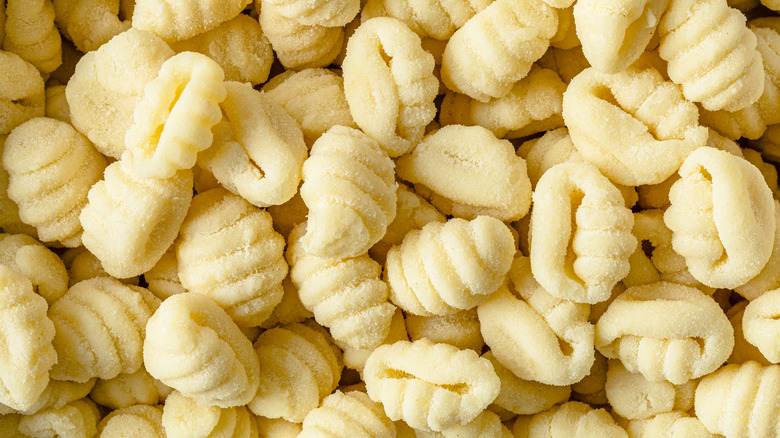The Story Of The First Gnocchi Doesn't Start In Italy
"Gnocchi by any name would still taste as sweet," to borrow and mangle a phrase from Shakespeare. Or... would it? Gnocchi can be made from a variety of different ingredients: flour, semolina, ricotta, pumpkin, spinach, and more. Although, perhaps the most popular form of gnocchi today features a potato base.
Potato gnocchi are made by steaming starchy spuds until soft, ricing them into a smooth grain, whipping in flour, eggs, and salt, then shaping the resulting dough into individual dumplings to boil. Foodies in Italy have been shaping potatoes into gnocchi since at least the 1600s. But, to truly ascertain the origin of these little dumplings, it's necessary to trace the potato's arrival in Italy in the first place. Even the word "gnocchi" itself has unclear etymological origins. Some linguistic historians trace the word to the Venetian "gnocco" (or "nocca") meaning "knuckles" or the German "knöchel," a nod to the gnarled dumplings' sauce-capturing ridges. Others link the word to "knohha" of the Gallo-Italic Lombard dialect of Northern Italy, meaning "knot."
Potatoes first reached Italian shores on the ships of Spanish explorers, who brought the crop back from South America. Before the arrival of the spud, in the 1400s, home cooks in Lombardy, Italy were shaping proto-gnocchi dumplings called zanzarelli from bread, ground almonds, and milk. Even before this, the ancient Romans were shaping gnocchi-like dumplings from semolina and eggs. In 1570, a gnocchi recipe appears in a Bartolomeo Scappi cookbook made from flour, water, and breadcrumbs (no spuds to be seen yet).
Potatoes didn't arrive in Italy until the 1500s, via Spanish explorers
Zanzarelli evolved to malfatti (meaning "badly made") in the kitchens of Sicilian home cooks, who added egg, flour, and water into the mixture. Before potatoes hit the scene, foodies in Friuli-Venezia Giulia and Piedmont were workshopping their gnocchi recipe with pumpkins, which provided more structural integrity and toothy chew than egg and flour alone. Finally, enter: potatoes.
When Christopher Columbus traveled the world collecting produce from various different climates and spreading that produce to new countries, the global ecological event known as the Columbian Exchange (1492-1800) began. Columbus might have carried the potato across the Atlantic, but it was the Spaniards under conquistador Francisco Pizarro who delivered the spud to Italy from the South American Andes in the 1500s. The species of potato that ended up in Northern Europe via Columbus originally come from Peru.
The crop found a happy home in the Veneto region of Northeastern Italy, where the cool climate suits the tuber's agriculture. It's perhaps no surprise, then, that Northeastern Italy is home to a long tradition of gnocchi-making, and is regarded as the official birthplace of the potato dumplings fans worldwide know and love today. Spaniards under the Catholic order of the Discalced Carmelites are credited with teaching Italian foodies how to cultivate potatoes– and they caught on quick. By the 1800s, a recipe for potato gnocchi nearly identical to the dumplings enjoyed by foodies today appears in a cookbook by Italian gastronomic giant Pellegrino Artusi.

